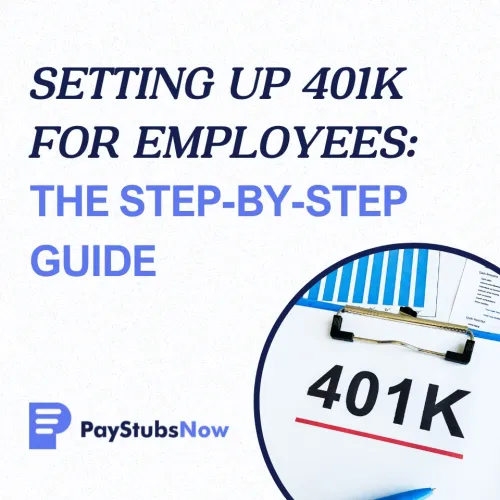


In today's competitive job market, retaining and attracting top talent is more crucial than ever. Companies must create an engaging and supportive work culture to stand out as an employer of choice .
Setting up a 401k plan is one of the most strategic moves an employer can make to not only attract but also retain top talent. It provides a critical financial benefit that enhances job satisfaction and demonstrates a commitment to your employees' long-term financial health.
Let’s explore how you can set up a 401k plan to enhance your employee benefits package and solidify your reputation as an employer who cares about their employees.

A 401k plan allows employees to allocate a portion of their earnings into individual accounts, which can be invested in a range of assets, such as mutual funds, stocks, bonds, and money market funds.
Contributions to a 401k are typically tax-deferred, meaning they are deducted from an employee’s paycheck before taxes are taken out, lowering the employee's taxable income for the year. Alternatively, some employers might offer a Roth 401k option where contributions are made after tax deductions, allowing for tax-free withdrawals in retirement. Both employees and employers can contribute to the plan.
Setting up a 401k plan for your employees offers several benefits for both your company and your workforce:
Investing in a retirement plan serves as a compelling benefit that attracts top talent and builds long-term employee loyalty. As you offer a retirement plan, employees feel more secure knowing their future financial needs are being addressed, and the company values its employees, increasing their commitment to work and organization.
Employers can enjoy tax benefits as their contributions to a 401K plan are tax-deductible, reducing the overall taxable income of the business and encouraging employee participation. With tax owed being reduced, cost savings derived from these tax benefits can be reinvested for growth and development.
By providing a structured way to save and invest for retirement, a 401K plan promotes long-term financial stability and reduces stress about future financial needs for employees.
These contributions are deducted directly from payroll, making saving effortless and consistent for the employees. As the investments are compounded annually, there is a significant increase in employee retirement funds. In many cases, these contributions bring down the salary from the taxable bracket, thus, saving on taxes.

A secure workforce with high morale and productivity is an asset for the organization. A 401k boosts employee financial security by enabling long-term savings and reducing taxable income, which ensures a more stable and secure financial future.
By offering a retirement plan, the organization provides a safety net for employees during their retirement years. This helps alleviate financial stress and insecurity, allowing employees to focus more on their work and perform better.
One of the standout features of a 401k plan is the potential for employer-matching contributions. This encourages employees to contribute more towards their retirement savings. Employers match employee contributions dollar for dollar up to a specified percentage of their salary, providing an immediate 100% return on the employee's contributions up to the matching limit.
Some employers may use a tiered matching system, such as matching 50% of the first 6% of the salary contributed.
Offering a 401K plan demonstrates a commitment to employee well-being. This not only portrays the company as responsible and desirable to work for but also boosts its overall reputation and standing in the industry. With such a reputation, the company appeals to top talent, making it easier to attract skilled and qualified candidates.
These actions show that the company is forward-thinking and competitive in the industry. They also demonstrate financial stability and long-term planning within the organization.
Establishing a 401k plan requires research, calculations, and analysis. Not sure where to start? Here's a step-by-step guide to set you on the right path.
To create a successful 401k plan, businesses should consider factors such as business size, employee demographics, budget, desired plan features, and compliance requirements. By understanding these factors, businesses can tailor their 401k plan to align with their business goals and meet the needs of their employees.
Here's what you should do to determine your specific needs:
When selecting a plan provider, begin by researching various providers and paying close attention to their services, such as compliance support, recordkeeping, and plan administration.
Compare costs to ensure they align with your budget while also evaluating the range of investment options available to your employees. Reviewing each provider’s reputation and customer support is also beneficial, often reflected in client testimonials and reviews.

The written plan is essentially the blueprint of your 401k program, detailing the rules, guidelines, and specifics of plan operations. Your summary plan description serves as a detailed and comprehensive document that communicates the plan's benefits, rights, and obligations to your employees.
To create these, follow these simple steps:
Include essential information such as the employer's name, the plan's eligibility criteria, contribution methods, investment options, and how to claim benefits.
To encourage employee contributions, it is important that you set up a trust for 401k plan assets and ensure the security and proper management of your employees' retirement funds.
It's important to keep detailed records and comply with all fiduciary responsibilities. Regular audits and reviews can help ensure that the trust operates in the best interest of plan participants, aligning with federal regulations and standards.
Developing a recordkeeping system is a crucial step in managing your company's 401k plan effectively. Maintaining detailed records of participant information, such as enrollment forms, beneficiary designations, and loan activities, is essential. For a reliable recordkeeping system:
Prepare a detailed summary that covers all important aspects of 401K as employees retirement savings plan. This summary should be written in a comprehensive language, avoiding overly technical jargon, and shared with plan participants.
One effective way to distribute this information is through a combination of methods:

Begin by providing clear, easy-to-understand information about the plan’s benefits, eligibility requirements, and enrollment procedures. Utilize online platforms, like those provided by your plan administrator, to facilitate digital enrollment forms.
Host informational sessions or workshops to guide eligible employees through the process and address any questions they may have. The process can be simplified by sticking to the simple steps here:
Now comes the crucial task of monitoring and maintaining it effectively. Regular oversight ensures the plan remains compliant with regulations and continues to meet the needs of your employees.
Here are some key steps to help you monitor and maintain your 401k plan:
Conduct annual nondiscrimination tests to ensure fair benefit distribution. These tests verify that plans do not disproportionately favor highly compensated employees, ensuring equity among all participants.
Setting up a 401k plan can be a game-changer for your business. From attracting and retaining top talent to providing invaluable tax benefits, the perks are immense. Along this journey, you’ll need to select a plan provider, manage employee enrollments, and expertly handle contributions. Keeping financial records in check is crucial, and that’s where Paystubsnow steps in.
With Paystubsnow, managing payroll deductions becomes easy with:
Ready to take your compensation and benefits planning to the next level? Visit Paystubsnow now to explore our comprehensive financial document solution